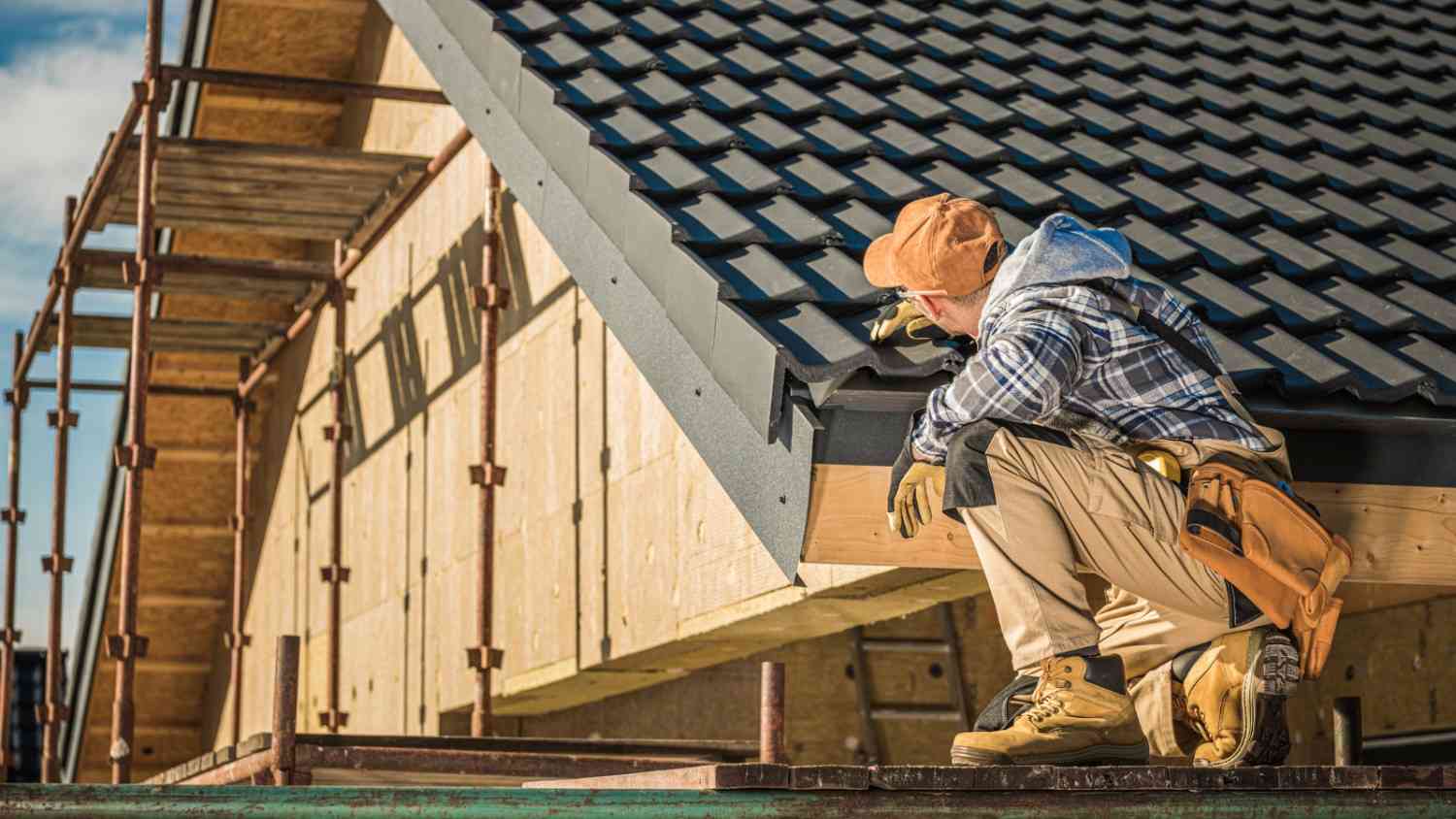California’s Title 24 requires Orange County homes to use cool roofing materials with specific solar reflectance (0.20-0.63) and thermal emittance (0.75+) values. Professional roof installation ensures compliance with these stringent energy efficiency standards. You’ll need compliance for projects covering 50% or more of your roof or exceeding 2,000 square feet. Coastal properties require higher insulation standards (R-38 for attics, R-19 for walls) and proper ventilation systems. While compliant materials cost 10-20% more initially, they offer significant long-term energy savings that offset your investment.
What Is Title 24 and Why It Matters for Orange County Homeowners
The California Building Energy Efficiency Standards, commonly known as Title 24, represent a crucial set of regulations that directly impact your roofing decisions in Orange County. These standards aim to reduce energy consumption in residential and commercial buildings while promoting sustainability through improved design and construction practices.
For Orange County homeowners, Title 24 compliance isn’t just about following rules, it delivers significant homeowner benefits. You’ll enjoy lower utility bills through mandated energy-efficient materials and installation techniques. Your home will maintain more consistent indoor temperatures, reducing your reliance on heating and cooling systems. Furthermore, Title 24-compliant roofing typically increases your property value and makes your home eligible for rebates and incentives designed to reward energy-conscious renovations.
Cool Roofing Requirements Under Title 24
Title 24 mandates specific cool roofing requirements that you’ll need to follow when replacing your Orange County home’s roof. Your new roof must meet minimum solar reflectance values (typically 0.20-0.63) and thermal emittance standards (usually 0.75 or higher) depending on your roof slope and material type. Proper cool roof installation requires certified materials and professional application to guarantee compliance while maximizing your home’s energy efficiency.
Solar Reflectance Minimums
Since California experiences significant heat during summer months, Orange County homeowners must comply with specific solar reflectance standards established under Title 24 building energy efficiency regulations. Your roof’s ability to reflect sunlight directly impacts your home’s energy efficiency and cooling costs.
| Roof Type | Minimum Solar Reflectance | Thermal Emittance |
|---|---|---|
| Low-slope | 0.63 | 0.75 |
| Steep-slope (Residential) | 0.20 | 0.75 |
| Steep-slope (Nonresidential) | 0.25 | 0.75 |
| Metal roofing | 0.28 | 0.75 |
| Reflective coatings | 0.65 | 0.85 |
You’ll need to choose roofing materials that meet these minimums. Many manufacturers now offer reflective coatings that comply with these standards while still providing aesthetic options. These requirements also facilitate easier solar panel integration, as cooler roofs improve photovoltaic efficiency.
Thermal Emittance Standards
Why does thermal emittance matter as much as solar reflectance for your Orange County home? Thermal emittance measures your roof’s ability to release absorbed heat, complementing reflectance for complete thermal performance. While reflectance rejects solar energy, emittance dissipates heat that does get absorbed.
Under Title 24, residential steep-sloped roofs in Orange County must maintain a minimum thermal emittance rating of 0.75, meaning they release 75% of absorbed heat. Flat or low-sloped roofs require 0.85 emittance. These standards guarantee your roof doesn’t trap heat, supporting energy conservation by reducing cooling demands during hot summers. When selecting roofing materials, you’ll need to verify their emittance ratings through product documentation or the Cool Roof Rating Council‘s certified products directory.
Cool Roof Installation
When planning your Orange County roofing project, you’ll need to comply with California’s extensive cool roofing requirements. Title 24 mandates cool roofing for most residential reroofing projects exceeding 50% of the roof area or 2,000 square feet, whichever is less.
Installation guidelines specify that qualified cool roofing products must be certified by the Cool Roof Rating Council (CRRC). Your contractor should install materials meeting minimum Solar Reflectance Index (SRI) values based on your roof slope: 20 for steep-slope roofs and 64 for low-slope applications.
The cool roof benefits extend beyond compliance, you’ll reduce cooling costs by up to 15%, decrease roof temperature by 50-60°F, and extend roof lifespan. Always verify your materials’ CRRC labels and maintain installation documentation for potential building inspections.
Solar Reflectance and Thermal Emittance Standards
Your roof’s solar reflectance can be measured through standardized tests that evaluate how much sunlight it reflects rather than absorbs. The Cool Roof Rating Council (CRRC) certifies products based on their reflectivity and thermal emittance values, providing homeowners with reliable performance data. When selecting roofing materials for your Orange County home, you’ll need to verify they meet or exceed the minimum solar reflectance index (SRI) requirements specified in local building codes.
Measuring Roof Reflectivity
Two critical measurements determine your roof’s energy efficiency in Orange County: solar reflectance and thermal emittance. Solar reflectance quantifies how much sunlight your roof reflects rather than absorbs, measured on a scale from 0 to 1, with higher values indicating better reflection.
Reflectivity measurement techniques vary by roofing material. Laboratories use spectrophotometers to precisely calculate reflectance values under controlled conditions. Field measurements employ portable reflectometers that provide quick assessments of installed materials.
When comparing roofing materials, you’ll find significant differences: traditional dark asphalt shingles typically score 0.05-0.15, while “cool” options like white metal roofing can reach 0.65-0.85. Title 24 compliance requires materials with reflectance values of at least 0.20 for steep-sloped roofs and 0.63 for low-sloped applications in Orange County.
Cool Roof Certification
To achieve Cool Roof Certification in Orange County, your roofing materials must meet specific standards established by the Cool Roof Rating Council (CRRC). Your roof must demonstrate minimum solar reflectance of 0.20-0.65 (depending on roof slope) and thermal emittance of 0.75 or higher.
When selecting materials, you’ll find a range of cool roof technologies that comply with these requirements, including specially coated metal, clay tiles, and composite shingles designed to reflect sunlight rather than absorb heat.
The certification process requires laboratory testing and product labeling that verifies performance metrics. Once certified, your roof qualifies for Title 24 compliance and may make you eligible for rebates or incentives. Beyond compliance, you’ll benefit from significant energy savings, typically 7-15% on cooling costs, while contributing to reduced urban heat island effects in Orange County.
Insulation and Ventilation Specifications for Coastal Properties
While inland Orange County properties face standard insulation challenges, coastal homes require specialized attention due to their unique climate conditions. You’ll need to install higher R-value insulation materials in your coastal property to combat the persistent moisture and salt air that can penetrate traditional barriers.
For peak performance, your attic should feature a minimum R-38 insulation rating, while your walls should maintain at least R-19. Furthermore, your ventilation systems must account for coastal humidity, install ridge vents and soffit combinations that create proper air circulation without allowing salt-laden air to become trapped.
Consider using closed-cell foam insulation rather than fiberglass in vulnerable areas, as it resists moisture penetration better. These specifications not only guarantee Title 24 compliance but also protect your home from the corrosive effects of marine environments. Understanding Orange County material selection helps homeowners choose appropriate insulation and roofing materials for coastal conditions.
Title 24 Compliance Options for Historical Orange County Homes
Steering Title 24 energy requirements for historical Orange County homes requires a delicate balance between preservation and compliance. You’ll find several pathways to meet regulations while maintaining your property’s historical integrity.
Consider the alternative compliance method, which allows flexibility in meeting energy efficiency standards without compromising architectural features. You can implement cool roofing materials that match historical aesthetics while reducing heat absorption. Many homeowners opt for high-performance insulation in attics and crawl spaces where modifications won’t affect visible historic elements.
When renovating, you’re permitted to use the California Historical Building Code, which provides exemptions for certain Title 24 requirements. This approach lets you preserve original windows, rooflines, and facades while strategically upgrading other components to improve energy efficiency without sacrificing historical preservation value.
Energy-Efficient Roofing Materials Approved for Southern California
Southern California’s intense sun exposure demands roofing materials that can withstand heat while reducing energy consumption in your home. Title 24 compliant options include cool-rated asphalt shingles with specialized granules that reflect solar radiation rather than absorbing it.
Clay and concrete tiles remain popular energy efficient options in Orange County, offering natural insulation properties with lifespans exceeding 50 years. Metal roofing systems with reflective coatings achieve high solar reflectance ratings while requiring minimal maintenance.
For flat or low-slope applications, you’ll find approved sustainable materials such as TPO (Thermoplastic Polyolefin) and PVC membranes in highly reflective white finishes. Many manufacturers now produce composite shingles made from recycled materials that meet both aesthetic requirements and Title 24 energy standards. Learning about long-lasting roof materials helps homeowners select compliant options that maximize both energy efficiency and durability.
Working With Certified Title 24 Contractors in Orange County
When selecting Title 24 compliant roofing materials, finding the right installation professional becomes your next essential decision. You’ll need certified contractors who understand Orange County’s specific climate challenges and building codes.
Look for professionals with California state licenses and specific Title 24 certification credentials. These contractors will help you navigate the complexities of energy compliance documentation and guarantee your roof meets all local requirements.
In Orange County, certified contractors can guide you through available rebates and incentives for energy-efficient installations. They’ll also provide proper documentation for building inspections and energy compliance verification.
Don’t hesitate to request proof of previous Title 24 projects. Experienced contractors should readily share their portfolio of compliant installations. Remember, proper installation by qualified professionals ultimately determines whether your new roof will deliver its promised energy performance. For expert Title 24 compliant installations, consider working with Truecraft Construction, a trusted Orange County specialist experienced in energy-efficient roofing systems.
Residents in specific areas can benefit from localized expertise, such as Garden Grove roofing services or Irvine roofing services, where contractors understand regional building requirements and Title 24 compliance procedures.
Cost vs. Long-Term Savings: The Financial Impact of Title 24 Compliance
Although homeowners often experience sticker shock when initially reviewing Title 24 compliant roofing costs, the initial investment typically pays dividends through substantial long-term savings. You’ll recoup expenses through reduced energy bills, as compliant roofing materials reflect more sunlight and minimize heat transfer into your home.
Your initial investment in cool roofing typically adds 10-20% to standard roofing costs but delivers long-term benefits including extended HVAC system lifespan and potentially qualifying you for rebates or tax incentives. Many homeowners report 15-30% reductions in cooling costs during Orange County’s warmer months.
When evaluating roofing options, consider the total cost of ownership over the roof’s lifespan rather than focusing solely on installation expenses. The energy efficiency gains often make Title 24 compliance financially advantageous within 3-7 years. Understanding roof replacement costs helps homeowners budget appropriately for compliant materials and installation while factoring in long-term energy savings.
Frequently Asked Questions
How Often Must Title 24 Compliant Roofs Be Inspected or Recertified?
Title 24 doesn’t mandate a specific inspection frequency for compliant roofs. You’ll need to follow your local building department’s recertification process, which typically occurs during renovations or when you’re selling your property.
Can I Get Exemptions for Partial Roof Replacements?
Yes, you’ll find partial replacements often have exemptions or alternative compliance options. If you’re replacing less than 50% of your roof, you typically won’t need to bring the entire roof up to current standards.
Are There Specific Title 24 Requirements for Accessory Dwelling Units?
Yes, accessory dwelling units must meet Title 24 energy efficiency standards. You’ll need compliant roofing, insulation, windows, and HVAC systems. New ADUs typically face stricter requirements than renovated existing structures.
How Do Wildfire Safety Codes Interact With Title 24 Roofing Requirements?
You’ll find wildfire regulations require fire-resistant roofing materials that must also meet Title 24 energy efficiency standards. These dual requirements often lead to Class A-rated cool roofs in high-risk areas.
What Permits Are Needed for DIY Title 24 Compliant Roof Installations?
You’ll need a building permit for DIY roofing. Submit your permit application to local building department, including your plans showing Title 24 compliance. Don’t skip inspection requirements when installing yourself.


